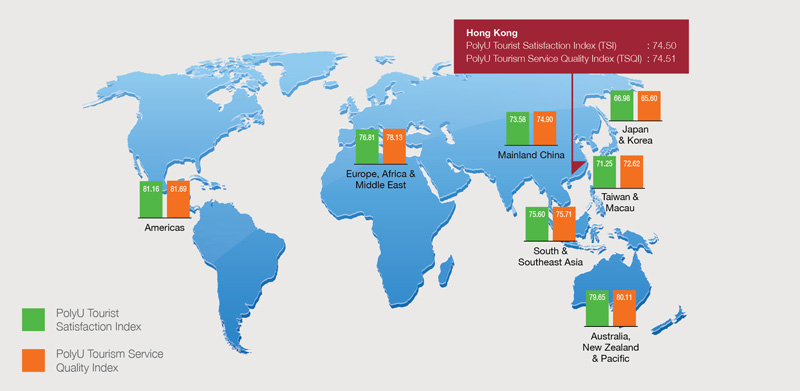
The School of Hotel and Tourism Management recently released the 2014 "PolyU Tourist Satisfaction Index" and "PolyU Tourism Service Quality Index" to help boost tourism development.
A tourist's overall satisfaction is undoubtedly determined by a combination of perceived value and quality, consumer expectations and actual experience, which influences the likelihood of repeat visitation, extended length of stay, increased expenditure, enhanced yield and word-of-mouth referrals. Measuring tourist satisfaction thus plays an important role in the marketing of tourism products and services. As part of its efforts to give back to the industry that supports it, PolyU's School of Hotel and Tourism Management (SHTM) recently released the 2014 PolyU "Tourist Satisfaction Index" (PolyU TSI) and "Tourism Service Quality Index" (PolyU TSQI), which stand at 74.50 and 74.51, respectively, out of a maximum 100.

"PolyU Tourist Satisfaction Index" (TSI) and "Tourism Service Quality Index" (TSQI)
Launched in 2009, the PolyU TSI measures inbound tourists' satisfaction levels across six tourism-related sectors and integrates them into an overall index, providing information for authorities and industry practitioners for use in decision making and planning. The 2014 PolyU TSI saw the largest ever decline of 1.46 points to 74.50. Tourists from the Americas recorded the highest TSI score of 81.16, followed by those from Australia, New Zealand and the Pacific (79.65), Europe, Africa and the Middle East (76.81), South and Southeast Asia (75.60), Mainland China (73.58), Taiwan and Macau (71.25), and Japan and Korea (66.98). The overall decline suggested that tourists were less satisfied with Hong Kong as one of the best destinations in the world than they had been in previous years, but Hong Kong's competitiveness in providing tourism service excellence and attracting international tourists remains high within the Greater China region.
The PolyU TSQI, launched in 2012, is a weighted average of the six tourism service quality indices, measuring overall tourism service quality. The industry can use this index to benchmark its service performance against tourists' growing expectations. Hong Kong's TSQI stood at 74.51 for 2014. As with the TSI, source markets were ranked in the same order, with tourists from the Americas being the most satisfied with overall service quality in Hong Kong. In relation to the six tourism service sectors considered, a general decline was also observed. Transportation ranked highest with a TSQI score of 78.32, followed by attractions (75.94), immigration (75.94), hotels (74.01), retail shops (72.56) and restaurants (71.88).
In addition, the deviation between the PolyU TSQI and PolyU TSI can help the industry to detect where service performance fails to boost tourist satisfaction. Serving as barometres of tourist satisfaction and tourism service quality for destinations, the two indices provide significant information with which stakeholders can formulate strategic plans to develop the tourism industry in a sustainable manner. ♦
